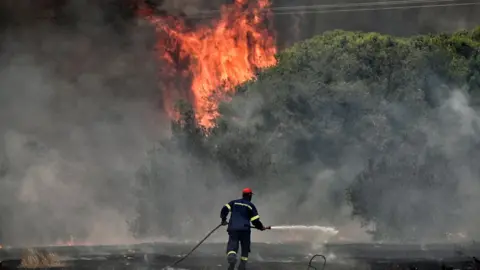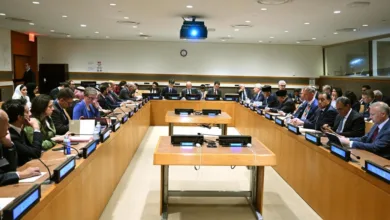Widespread Heatwaves Fuel Wildfire Risks Across Europe

Europe is currently facing one of the most severe heatwaves in recent history, raising alarm among scientists, governments, and the general public. The intense heat has fueled widespread wildfire risks, threatening communities, ecosystems, and critical infrastructure across the continent. As authorities scramble to contain fires and prevent further devastation, the situation has become a major focus in Breaking News and World coverage.
Record-Breaking Temperatures
Meteorological agencies across Europe report unprecedented temperature highs, with several regions experiencing temperatures exceeding 40°C (104°F). Southern Europe, particularly Spain, Portugal, Italy, and Greece, has been most affected, while northern regions are also seeing unusually warm conditions.
Experts link these extreme temperatures to climate change, noting that heatwaves of this intensity are becoming increasingly common. The situation has been described as a “climate emergency,” demanding immediate action from governments and local authorities.
Wildfire Risks and Current Incidents
Southern Europe at Highest Risk
The combination of extreme heat, dry conditions, and strong winds has created ideal circumstances for wildfires to ignite and spread rapidly. Spain and Portugal have already declared states of emergency in several regions, deploying firefighters and military personnel to combat flames threatening homes and forests.
Italy and Greece are facing similar challenges, with evacuations underway in multiple villages and towns. The fires have destroyed thousands of hectares of forest, disrupted electricity and water supply, and forced the closure of key transportation routes.
Northern Europe
Even countries traditionally less affected by wildfires, such as Germany, France, and the United Kingdom, are experiencing increased risks. Authorities have issued heat advisories and encouraged citizens to take precautions against both fire hazards and health risks associated with extreme temperatures.
Impact on Communities
The human cost of these heatwaves and wildfires is significant. Thousands of residents have been forced to evacuate, and emergency shelters are struggling to accommodate displaced families.
Healthcare systems are under pressure, treating heat-related illnesses and injuries caused by fires. Vulnerable populations, including the elderly, children, and those with pre-existing conditions, are particularly at risk.
Environmental Consequences
Wildfires not only threaten human life but also have severe environmental repercussions. Forests, wildlife habitats, and biodiversity are at risk, and smoke from fires is contributing to poor air quality across Europe.
Carbon emissions from wildfires further exacerbate global climate change, creating a feedback loop that may increase the frequency and intensity of future heatwaves. Experts warn that Europe could see more devastating fire seasons if immediate climate mitigation measures are not implemented.
Government Response
Emergency Measures
Governments across Europe have activated emergency protocols, deploying firefighters, helicopters, and military assistance to contain fires. Evacuation orders have been issued in high-risk areas, and local authorities are coordinating with international partners to mobilize resources.
Policy Initiatives
In addition to immediate firefighting efforts, European governments are evaluating long-term policies to address wildfire risks and climate adaptation. This includes reforestation programs, improved early warning systems, and investment in sustainable land management practices.
Coordination Across Borders
Given the transnational nature of wildfires and climate impacts, European Union agencies are playing a crucial role in coordinating disaster response. Cross-border collaboration ensures that resources, expertise, and aid are effectively deployed where most needed.
Scientific Insights
Climate scientists emphasize that the current heatwave is part of a broader trend of rising global temperatures. Factors contributing to wildfire risks include:
-
Prolonged drought conditions.
-
High temperatures combined with low humidity.
-
Vegetation drying out rapidly due to heat stress.
-
Increasing frequency of extreme weather events.
Studies suggest that without significant reductions in greenhouse gas emissions, Europe can expect more frequent and severe heatwaves, increasing the risk of wildfires and associated disasters.
Economic Implications
The heatwave and wildfire crisis also have economic consequences. Tourism, agriculture, and energy sectors are particularly affected. Crop yields are threatened by drought, while tourism in fire-prone areas is disrupted. Power outages due to fire damage to infrastructure further strain economic activity.
Insurance companies are facing rising claims, and governments may need to allocate additional funding for disaster relief and rebuilding efforts. The economic impact highlights the need for both short-term emergency planning and long-term climate resilience strategies.
Health and Safety Concerns
Authorities have emphasized the importance of public health measures during the heatwave. Recommendations include:
-
Staying hydrated and avoiding outdoor activities during peak heat hours.
-
Monitoring vulnerable family members and neighbors.
-
Following evacuation orders promptly in fire-affected areas.
-
Using masks or air filters to reduce smoke inhalation.
Hospitals and clinics are on high alert, particularly in regions where wildfires overlap with dense population centers.
Role of Media Coverage
Media outlets have extensively covered the heatwave and wildfires, providing real-time updates on evacuation zones, road closures, and emergency services. Reporting on News and World platforms has played a crucial role in keeping the public informed and aware of the unfolding crisis.
Social media platforms are also being used for crowd-sourced reporting, helping authorities track fire spread and coordinate rescue operations.
International Response
Countries outside Europe have expressed solidarity, offering assistance through specialized firefighting teams, equipment, and financial aid. International cooperation is seen as vital in combating large-scale disasters exacerbated by climate change.
Organizations such as the United Nations have called for increased global attention to climate-induced risks, stressing that heatwaves and wildfires are no longer isolated events but part of a worldwide pattern.
Preventive Measures and Future Planning
Experts and policymakers advocate for proactive measures to reduce wildfire risks in the future:
-
Enhancing early warning systems using satellite and AI technology.
-
Promoting sustainable forestry and land management practices.
-
Educating communities about fire prevention and response strategies.
-
Strengthening infrastructure to withstand extreme heat and fire damage.
Implementing these measures can reduce the vulnerability of communities and ecosystems, helping Europe adapt to the realities of a warming climate.
Conclusion: Climate Urgency
The widespread heatwaves across Europe highlight the intersection of climate change, public safety, and environmental sustainability. Wildfire risks pose immediate threats to human life, economic stability, and ecological balance.
As authorities continue to manage the crisis, the situation serves as a stark reminder of the urgent need for global climate action. Collaboration across nations, investment in sustainable practices, and public awareness are essential to mitigate the growing dangers of extreme heat and wildfires.
The ongoing heatwaves remain a priority on Breaking News and World agendas, emphasizing the critical importance of preparation, adaptation, and resilience in the face of climate change.




